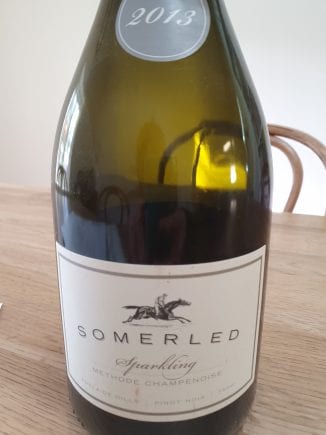 I’m doing Dry July…
I’m doing Dry July…
(yes, I don’t know what I was thinking either!)
And while we’re on the topic of going dry… I’m starting to worry that I’m going to run out of blog topics. Surely I won’t, but there has to be a limit, right? (don’t answer that)
I do have a couple of very interesting topics up my sleeve, but they all required a bit more research than I had time for this week. In the meantime (and to help stretch my new ideas out a bit), I’m going to start revisiting some of my early posts. I began this blog back at the start of 2018 and I’ve learned a lot since then. I’ve also gained a few readers along the way, so some of this content will be new to you or it might just be a reminder of some interesting wine-related topics. Either way, I hope you’ll join me on this trip down memory lane!
Anyway, back to Dry July. Or should I say Dryish July…?
Because it just happened to be my little person’s birthday yesterday and I figured I deserved a day off to celebrate that (it’s as much about me as it is him, right?!!)!
And what better way to mark the occasion than with a 2013 Somerled Sparkling?
What better way to mark ANY special occasion than with a bottle of high quality sparkling wine?!
We get a lot of questions about how sparkling wine is made. Especially seeing ours is made in the “traditional method”.
Here are a few of the common ones…
How do you make Sparkling wine using the traditional method?
The most important thing about the traditional method is that the process of turning a still wine to a sparkling wine occurs entirely inside the bottle. The same bottle you end up pouring your celebratory glass from.
Let’s have a look at how it is done from start to finish though…
- Making the base wine: as with any wine the grapes are picked (usually early to preserve acidity) and fermented into a dry wine. If the base wine is a mix of varieties (eg. Pinot Noir and Chardonnay), the winemaker blends them together into what the French call a “cuvée” – the final sparkling wine blend.
- Tirage: Yeast and sugars are added to the cuvée to start the second fermentation and wines are bottled (and topped with crown seals).
- Secondary fermentation: the fermentation which happens inside the bottle to create the bubbles. It adds a little more alcohol (just over 1%) and creates carbon dioxide gas.
- Aging: the wines are then aged on the dead yeast cells (or “lees”) to develop texture in the wine. In Champagne, the minimum amount of time specified by the region is 1.5 years. Our Somerled sparkling is aged for around the same amount of time before its first release. It’s usually had much longer than this by the time we get to the last bottles of a vintage.
- Riddling: Funnily enough, consumers prefer their sparkling wine not to have dead yeast cells in the bottom of it! Remuage (or “riddling” in English) is the beginning of the process for removing the lees. It is performed either manually or mechanically, to gradually invert the bottle and settle the lees into the neck.
- Disgorging: This is the final part of the “removing the crud from the bottle” process. The bottles are placed upside down into freezing liquid which causes the yeast lees to freeze in the neck of the bottle. The crown cap is then popped off which allows the frozen chunk of lees to shoot out of the pressurised bottle.
- Dosage: Finally the bottles are topped up with a mixture of wine and sugar (usually in the form of grape juice). Then they are corked or crown-sealed and labelled. The dosage is not only designed to replace the volume lost during the disgorging process but gives the winemaker a chance to adjust the sweetness of the wine. For Rob, the dosage he uses is much drier than most.
What other ways are there to make sparkling wine?
A large proportion of Australian Sparkling wine is not made using this time consuming and expensive method. There are other ways to make Sparkling wine, including…
Tank Method:
The major difference between the tank method and the traditional method is the removal of the individual bottle as the vessel used to turn a still wine into a sparkling one. Basically, the same process is done on the wine as a whole in a tank.
Transfer Method:
Identical to the Traditional method except that instead of riddling and disgorging, bottles are emptied into a pressurised tank and sent through pressurized filters to remove the lees.
Ancestral Method:
This method uses freezing temperatures to pause the fermentation mid-way for a period of months and then wines are bottled and the fermentation finishes, trapping the carbon dioxide in the bottle.
Continuous Method:
This method is used by the Russians and is by far the most convoluted method have ever seen to make… well, anything. That is all I have to say on the matter! If you want a real explanation read this!
Carbonation:
This is the one that most Australian sparkling wines producers use (if they’re not using the traditional method). The carbonation method simply takes a still wine and carbonates in a pressurized tank. Just like how your soda stream works at home. But we don’t recommend using your soda stream to add bubbles to your wine (I may or may not have tried this but don’t tell Rob… he’d be mortified!)!
Why is it called the “Traditional Method”?
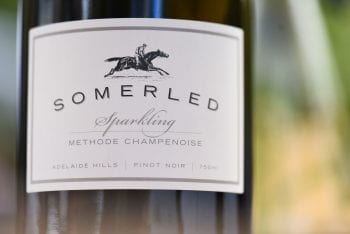 Or you may also see “Methode Traditonelle” on labels.
Or you may also see “Methode Traditonelle” on labels.
All that means is that it is made in the same way that Champagne from the Champagne region of France is made. It’s a way for us Aussies (and anyone producing sparkling wine in the traditional method outside of Champagne) to let everyone know we’ve used the fancy, time-consuming method to make our sparkling.
We used to be able to use the words “Methode Champenoise” (or in the method of sparkling wines produced in the region of Champagne). But as is the case for the term “Champagne”, the French didn’t like us using that either.
Hang, on… what do you mean they didn’t like it?
Although sparkling wines are produced around the world, legally the word Champagne is reserved exclusively for sparkling wines from the Champagne region in France and made in accordance with regulations governed by the Comité Interprofessionnel du vin de Champagne (CIVC) and protected under a treaty (so, I guess they’re pretty serious about it!).
For champagne to be champagne, the grapes need to be sourced from specific parcels in the Champagne appellation (which is short for a long fancy French term which means “protected designation of origin”) using specific vineyard practices, pressed using regimes unique to the region and made using secondary fermentation of the wine in bottle to create the bubbles.
How do you make a Sparkling white wine out of a red grape variety?
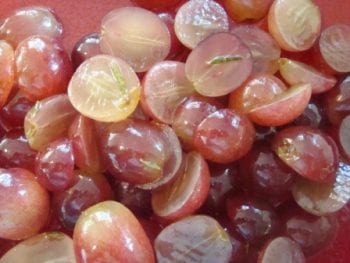
As you probably know, our sparkling white is made from Pinot Noir. But hang on isn’t that a red grape?
It sure is, but if you bite into a red grape, what colour is the flesh? Most red grapes have white flesh. In fact, there are very few varieties of red grapes in the world that have red flesh (Alicante is one of them). Actually, the only thing the contributes to the colour of red wine is its skin.
So, if you press the grapes ever so carefully and remove immediately separate the juice from the skins then you can make a white wine!
Traditionally, Sparkling wine is made from Pinot Noir, Pinot Meunier and Chardonnay.
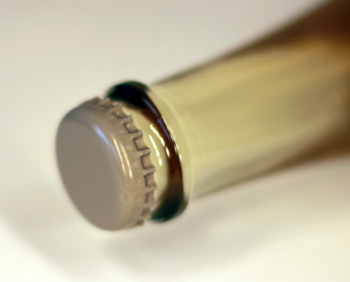
Why does Rob use a crown seal instead of a cork?
Well, firstly, he’s terrified someone will take an eye our with a cork! Secondly, with a crown seal there is very little chance that any gas can escape the bottle, meaning you can hang onto a bottle of Somerled Sparkling for years and it will be just as bubbly as it is today. Given the porous nature of cork, it is inevitable that some of those bubbles will disappear over time.
Tell me about riddling…
Riddling (or ‘remuage’) involves the gradual tilting of the bottle neck-down (‘sur pointe’), meanwhile rotating it by small increments, clockwise and anti-clockwise. As the angle of tilt increases, the forces of gravity draw the sediment into the neck.
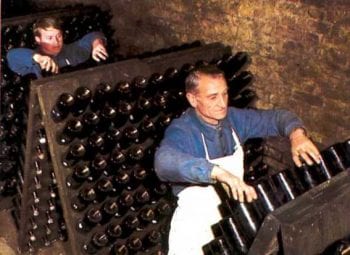
Remuage is still sometimes done manually, using a riddling rack (or ‘pupitre’) and a shaking and twisting technique practised over the centuries by skilled cellar masters. A good ‘remueur’ (bottle turner) can handle roughly 40,000 bottles a day.
The bottles are placed neck down in the rack and rotated by stages. 1/8 or 1/4 of a turn at a time, to the right or left, with a chalk mark on the bottom of the bottle for reference. The objective is to consolidate the sediments and leave the wine crystal clear. Manual remuage takes 4-6 weeks and involves on average 25 turns per bottle.
These days, automated remuage is much more common. It uses a machine called a ‘gyropalette’ and can process 500 bottles in a single operation. Gyropalettes work 24 hours a day and take a fraction of the time. Just one week instead of six.
Why do I feel so tipsy after a glass of sparkling wine?
It is a fact that drinking sparkling wine results in higher blood alcohol content. So, it’s not surprising you can feel the effects pretty quickly.
The reason for this is the bubbles! Carbon dioxide increases the permeability of your stomach lining and lets more alcohol into your bloodstream.
Thanks for re-visiting this fascinating topic with me. Tune in next week for something fresh and new. And of course, if you think you have any interesting ideas for a post, then let me know in the comments or send me an email. I love hearing from you!